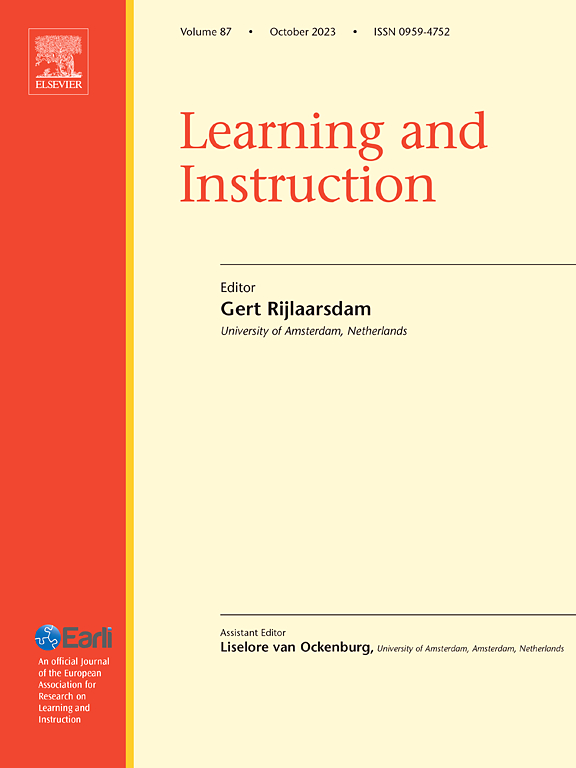Learning by writing: The influence of handwriting and typing on novel word learning in typically developing readers and readers with dyslexia
IF 4.9
1区 教育学
Q1 EDUCATION & EDUCATIONAL RESEARCH
引用次数: 0
Abstract
Background
Writing-based spelling is crucial for acquiring written word knowledge, contributing to form lexical representations that integrate motor information. Modern educational settings incorporate multiple modalities, with typing increasingly complementing handwriting. However, evidence on their relative effectiveness in supporting orthographic and semantic learning, particularly when these processes are impaired, remains limited.
Aims
This study examines the impact of the two writing modalities on the learning of orthographic and semantic information in typically developing (TD) children and those with developmental dyslexia (DD).
Sample
Eighteen Italian middle school students with DD and eighteen age-matched TD readers participated.
Methods
Participants learned a set of nonwords, varying in transcription regularity, paired with images, either through typing or handwriting. Their spelling and nonword-image association skills were then tested. Recorded metrics included accuracy, writing duration during learning and spelling tasks, and reaction time in the nonword-image mapping task.
Results
TD children benefited from both writing modalities during learning. Crucially, the DD group showed better spelling and nonword-image association performance when learning occurred through typing. Accuracy in retrieving orthographic and semantic information was not significantly affected by the time spent handwriting or typing during learning. Performance differences based on transcription complexity provided insights into the extent to which children internalized lexical representations.
Conclusions
Both writing modalities can support orthographic and semantic learning, but the complex graphomotor demands of handwriting may hinder novel word acquisition in dyslexic individuals. Incorporating typing into educational strategies could alleviate the cognitive load associated with handwriting and enhance word retention for these students.
通过书写学习:书写和打字对正常发展的读者和有阅读障碍的读者学习新单词的影响
背景基于书写的拼写对于获得书面单词知识至关重要,有助于形成整合运动信息的词汇表征。现代教育环境采用了多种模式,打字与手写的互补性越来越强。本研究探讨了两种书写模式对发育正常(TD)儿童和发育性阅读障碍(DD)儿童学习正字法和语义信息的影响。方法参与者通过打字或手写的方式学习了一组非词,这些非词的转录规则各不相同,并与图像配对。然后测试他们的拼写和非词-图像联想能力。记录的指标包括准确率、学习和拼写任务中的书写持续时间以及非词-图像映射任务中的反应时间。最重要的是,通过打字学习时,聋哑儿童组的拼写和非文字图像联想表现更好。正字法和语义信息检索的准确性并未受到学习过程中手写或打字时间的显著影响。结论两种书写方式都能支持正字法和语义学习,但手写对图形运动的复杂要求可能会阻碍阅读障碍患者掌握新词。将打字纳入教育策略可以减轻手写带来的认知负担,提高这些学生的单词记忆能力。
本文章由计算机程序翻译,如有差异,请以英文原文为准。
求助全文
约1分钟内获得全文
求助全文
来源期刊

Learning and Instruction
Multiple-
CiteScore
11.30
自引率
4.80%
发文量
109
期刊介绍:
As an international, multi-disciplinary, peer-refereed journal, Learning and Instruction provides a platform for the publication of the most advanced scientific research in the areas of learning, development, instruction and teaching. The journal welcomes original empirical investigations. The papers may represent a variety of theoretical perspectives and different methodological approaches. They may refer to any age level, from infants to adults and to a diversity of learning and instructional settings, from laboratory experiments to field studies. The major criteria in the review and the selection process concern the significance of the contribution to the area of learning and instruction, and the rigor of the study.
 求助内容:
求助内容: 应助结果提醒方式:
应助结果提醒方式:


